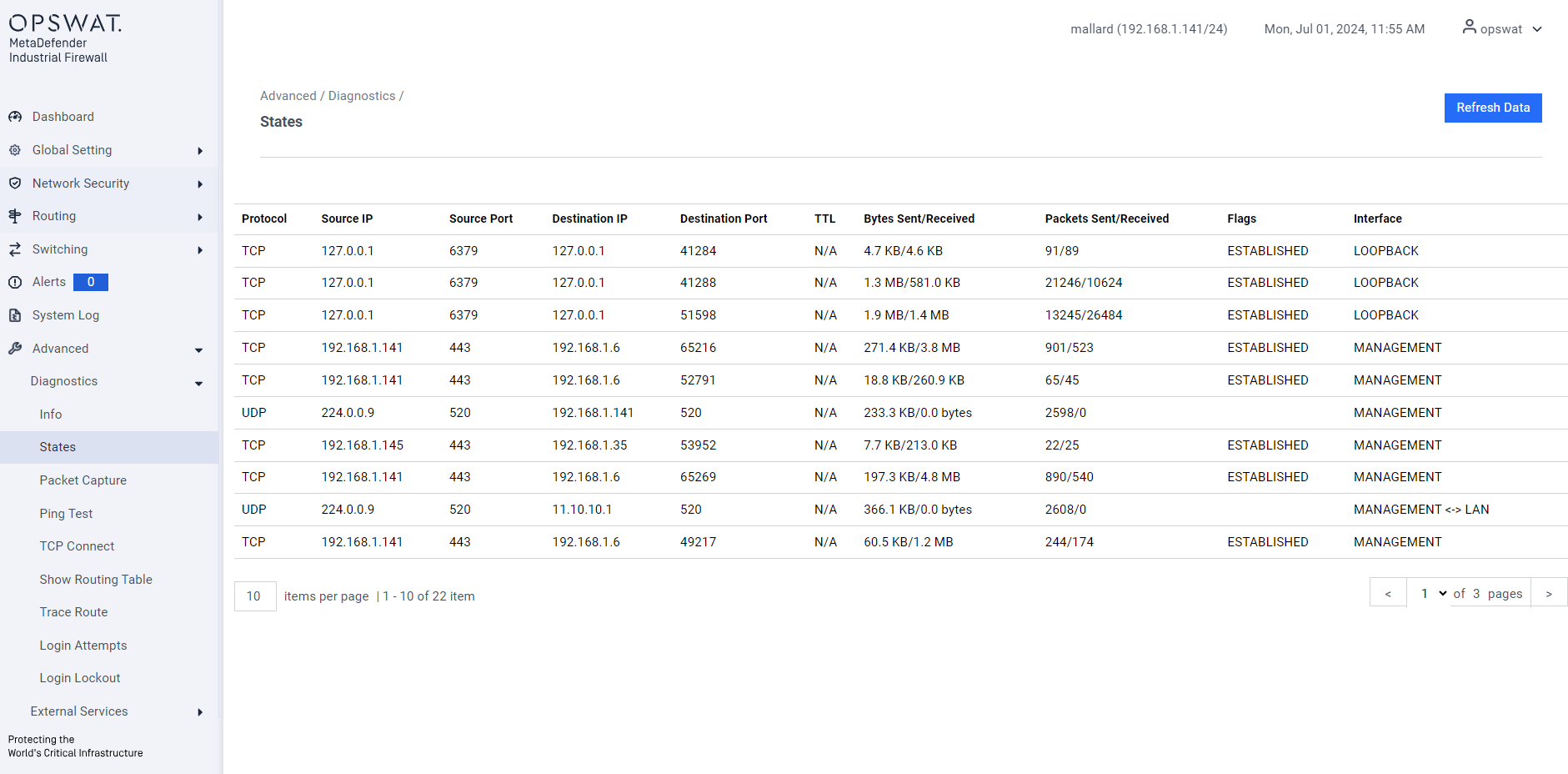The Advanced menu allows super administrators to view and update information about the appliance and to run diagnostics about the appliance.
You must enable the Advanced menu before it becomes visible. Refer to Change Settings for more information.
Diagnostics
Use the Diagnostics menu options to run tests on the instance.
States

- Protocol: The communication protocol used (e.g., TCP, UDP).
- Source IP: The IP address of the device sending the data.
- Source Port: The port number on the source device.
- Destination IP: The IP address of the device receiving the data.
- Destination Port: The port number on the destination device.
- TTL: Time to live
- Bytes Sent/Received: The amount of data sent and received.
- Packets Sent/Received: The number of packets sent and received.
- Flags: Indicators used to control or identify specific conditions in the communication.
- Interface: The network interface through which the data is transmitted.
Packet Capture
Click the Packet Capture option to view packet capture information and perform packet capture operations. The Packet Capture pane displays the following information:
- Name: Name of the packet capture (PCAP) file
- Created: Date the file was created
- Size: Size of the file
Notes:
- You can perform packet capture for 5 minutes or until 100 MB data are captured. After either endpoint is reached, packet capture stops automatically.
- Each packet capture is saved as a .pcap file. You can change the name when you export the file.
- Up to 10 PCAP files are allowed. If you start a PCAP operation after the 10th file is created, a message displays.
Run Packet Capture
1) Click the Start Pcap button. The Capture Status changes to Running, and a time counter displays, showing how much longer the packet capture will run.
2) Click the Stop Capture button to halt the packet capture before the time is up or 100 MB of data are collected.
Export a PCAP file
You must export the PCAP file before you can view the packet capture data.
Important:
- The appliance encrypts all PCAP files and provides an additional .enc suffix. You must decrypt the exported file before you can open it, and you cannot open the file with a typical network.
1) Click the Export button next to the file you want to export. A Download Pcap window displays.
1) Enter and confirm the password you want to use to decrypt the file in the Password fields.
2) Enter a new name for the file in the Filename if you want.
3) Click the Submit button. The file is exported to the default download location on your browser. You will see the file in the download location with a .pcap.enc extension.
Delete a PCAP file
1) Click the Delete button next to the file you want to delete.
2) Click the Submit button. The file is deleted from the Packet Capture pane.
Hot Processes
Click the Hot Processes option to view a list of processes using a high % of CPU.
System Counters
Click the System Counters option to view a list of counters that provide insight into appliance performance. The list can be sorted by name (alphabetical) or by value (# of counts). You can type into the filter box to search for specific counters.
Ping Test
Click the Ping Test option to run a ping test. Enter the server IP address or hostname in the Target Address box and click the Submit button. The results from the ping display.
TCP Connect
Click the TCP Connect option to view the result of the handshake between the client and the server that’s listening. __
1) Enter an IP address or hostname in the Target Address box.
2) Enter a port number (required).
3) Click the Submit button. The handshake results display
Show Route
Click the Show Route option to view the route the packet took to get to its destination. Enter an IP address or hostname in the Target Address box and click the Submit button. The route displays.
Trace Route
Click the Trace Route option to display the route and time the packet took to get to its destination. It will do a maximum of 30 hops at 60 bytes per packet. Enter an IP address or hostname in the Target Address box and click the Submit button. The route and time display.
Statistics
Use the Statistics options to view information about the Processes running on the appliance and the amount of space used by each File System associated with the instance.

